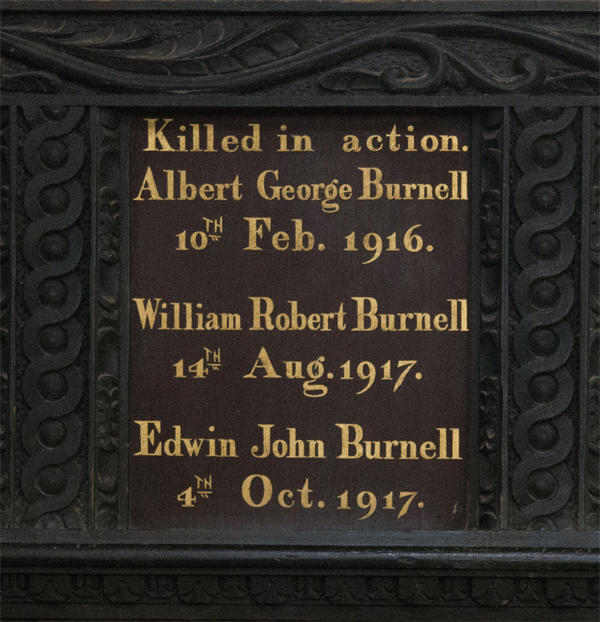Edwin John Burnell
Family
Edwin John Burnell (Eddie, as he was known in the family) was not a native of Dartmouth but was born in Ardglass, Co. Down, in Ireland, in 1892, where his father, William Burnell, was serving as a Commissioned Boatman in the Coastguard Service. For more on William Burnell's career, see the story of Eddie's elder brother, (Albert) George Burnell. Eddie was the youngest of eight children of William Burnell and his wife, Mary Ann May.
The family moved to Dartmouth after William's retirement from the Coast Guard, after Eddie's eldest sister Charlotte married John Edward Harris, a postman, from Dartmouth. At the time of the 1911 Census, the family lived at 3 Alexandra Cottages, Above Town - in the seven-room house were John and Charlotte and their three children; and also William, Mary Ann, Eddie, and his elder sister Gertrude, and brother George. By this time, Eddie was nineteen, and worked as a stationer's assistant. Eddie's brother William Robert (also on our database) had moved to London before his father's retirement, was married, and lived in Leyton, Essex.
In 1912, Eddie married Jane Yeats - how they met is not known. Jane was a daughter of John Yeats and his wife Ellen. John came originally from Christow, in Devon, but had travelled around the country following his trade as a miner and quarryman. Jane was born in Dalton in Furness, Lancashire; at that time her father mined iron ore. Later the family returned to Christow, where he obtained work mining barytes (barium sulphate). This industry had developed in the Teign Valley from the late 1870s when this mineral began to be used in a range of products, including paint.
Eddie and Jane had two children, John William, born 1913, known as Billy, and Terence Yeats, born in 1914.
Service
Eddie's service records have not survived but from other records we know that he joined the Devonshire Regiment. His service number, 14619, suggests that he joined up later in 1914 (see, for example, Alfred Charles Partridge, number 14824, who joined the Devons around end November/early December). His brother George, already referred to, had already joined the Devons. They appeared together in one of the lists published in the Dartmouth Chronicle of those serving in the Forces, on 18th December 1915; George was in the 8th Devons, while Eddie was reported to be in the 11th Devons, a reserve and training battalion.
By this date, however, George, who had indeed joined the 8th Devons, had been in France nearly five months; while Eddie had been posted to the 9th Devons, arriving in France on 1st October 1915. The 8th and 9th Battalions of the Devonshire Regiment were both part of the Seventh Division, frequently serving turn and turn about. Contacts between them remained close; Eddie, as a member of the 9th Devons, was notified the following day about his brother George's death on 10th February 1916. According to a letter from him to his elder sister Charlotte he saw George's body at the mortuary, and reported that George was buried with full honours.
According to information published in the Dartmouth Chronicle at the time of Eddie's death (see below) he:
.... for some time served in the bombing section of one of the Devon battalions, raiding the German trenches and capturing with his comrades many prisoners. Subsequently he was transferred to another battalion of the Devons, and at the time of his death he was serving as a machine gunner".
Records show that the "other battalion" to which Eddie transferred was the 1st Devons, but no information has yet come to light enabling the date of his transfer to be identified. Nor is it known with which battalion he was serving when promoted to Lance Corporal.
The 9th Devons, formed after the outbreak of war, had arrived in France on 28th July 1915. Eddie joined them after they had fought in the Battle of Loos, and suffered heavy casualties. The Battalion included several men from, or connected with, Dartmouth - for their experiences to April 1917, see the stories of Alfred Edgar Willing, killed at Loos in 1915, Robert Phillips Willing and Ernest Leonard Memory, killed on the Somme in 1916, Thomas Alfred Smith, who died of septaecaemia early in 1917, and Samuel Courtman, killed on 2nd April 1917 during the attack on Ecoust-Saint-Mein, south of Arras.
The 1st Devons were a regular army battalion, mobilised at the outbreak of war. They went to France on 21st August 1914. They too included several men from, or connected with, Dartmouth - for their experiences to April 1917, see the stories of (Robert) George Peters, killed on the Somme in 1916, Cyril Privett, killed in the Cuinchy sector of the front line on 30th January 1917, and Alfred Charles Partridge, already referred to, killed in the Battle of Arras on 23rd April 1917.
As it is not known when Eddie transferred to the 1st Devons, we take up their story in May 1917. The Battalion had sustained heavy casualties on 23rd April, and again in an action on 8th/9th May, when the village of Fresnoy was lost. According to the Regimental History, this "had nearly wiped the battalion out". After this, they remained out of the line for just over a month.
They returned on 14th June to the same sector (between the villages of Arleux-en-Gohelle and Oppy, north east of Arras), but by this time the active fighting had stopped, and the sector remained relatively quiet. The Battalion's War Diary is uninformative, observing on many days that "nothing of note occurred", but the Regimental History summarises this period as follows:
"Quietness", even in trench-warfare, is a relative term ... The 1st Devons found this line far from good, but they left it really strong and well-wired. Patrols were active all the time, but got scanty chances of distinction in encounters with the enemy, for the Germans were little disposed to do much.
The 5th Division, of which the 1st Devons were part, was able to push forward the line, taking Oppy wood on 28th June, though this did not involve the Devons. The Divisional History paints a rather extraordinary picture of this sector at the front in July and August:
There was great activity in the air all this time, large British bombing squadrons were often seen flying over, and there were many aerial fights ... the Vimy glacis [slope] ... which in April was a shot-ridden sea of brown mud, was now a waving mass of flowers, mostly poppies, daisies, and cornflowers - the colours of the Tricoleur. There were crowds of butterflies too, chiefly Red Admiral and Painted Ladies, and the GOC, who was an ardent entomologist, was seen one day chasing a Swallowtail, which he captured with his tin hat ... Polo was started on a flat bit of ground ... Sports and Horse-Shows were held, producing keen competition among Battalions and Batteries ...
This period enabled the 1st Devons gradually to rebuild. According to the Regimental History, between 10th May until 25th September, when the battalion began the move to Flanders, "drafts and men rejoining exceeded sick and casualties - there were only 40 of the latter - by nearly 500, which brought the battalion's paper strength nearly up to establishment". If he had not joined the 1st Devons before the Battle of Arras, Eddie presumably joined at some point during this period.
The Third Battle of Ypres
The Third Battle of Ypres had begun on 31st July 1917 - for the background to this offensive, see the story of William John Farrow Bates, of the 2nd Devons, killed on the first day while attacking east of the city.
The Burnell family had already suffered one casualty during the battle. Eddie's elder brother William Robert Burnell, who had enlisted in Leyton, Essex (where he lived with his wife and son), most probably late in 1915, had arrived in Flanders with the 10th Rifle Brigade on 20th July. His battalion was not required for the attack on the first day but was brought forward for a follow-up attack on the village of Langemarck on 14th August. According to a letter sent to his wife by the chaplain, later published in the Dartmouth Chronicle, William was a stretcher-bearer and was killed trying to help his commanding officer, who had been wounded.
On 25th August, General Haig transferred responsibility for planning the next stage of the offensive to General Plumer, commanding Second Army, from General Gough, commanding Fifth Army. General Plumer first wanted three weeks preparation, before a series of "bite and hold" attacks, in four steps, each followed by a six-day pause, to allow for consolidation, defence against any counter-attack, and preparation of the next step.
The first step, now called the Battle of Menin Road, had begun on 20th September, in good weather, and - broadly - achieved its objectives. After the requisite six days, the next step, now called the Battle of Polygon Wood, was launched on 26th September. Although an attack by the Germans intended to disrupt preparations had some success, the front was pushed forward another 1000-1250 yards. In the third step on 4th October, the Second Army (now including the 1st Devons) attacked the Broodseinde Ridge, the Zonnebeke Spur and Gravenstafel Spur, whilst the Fifth Army alongside them to the north moved on Poelcappelle.
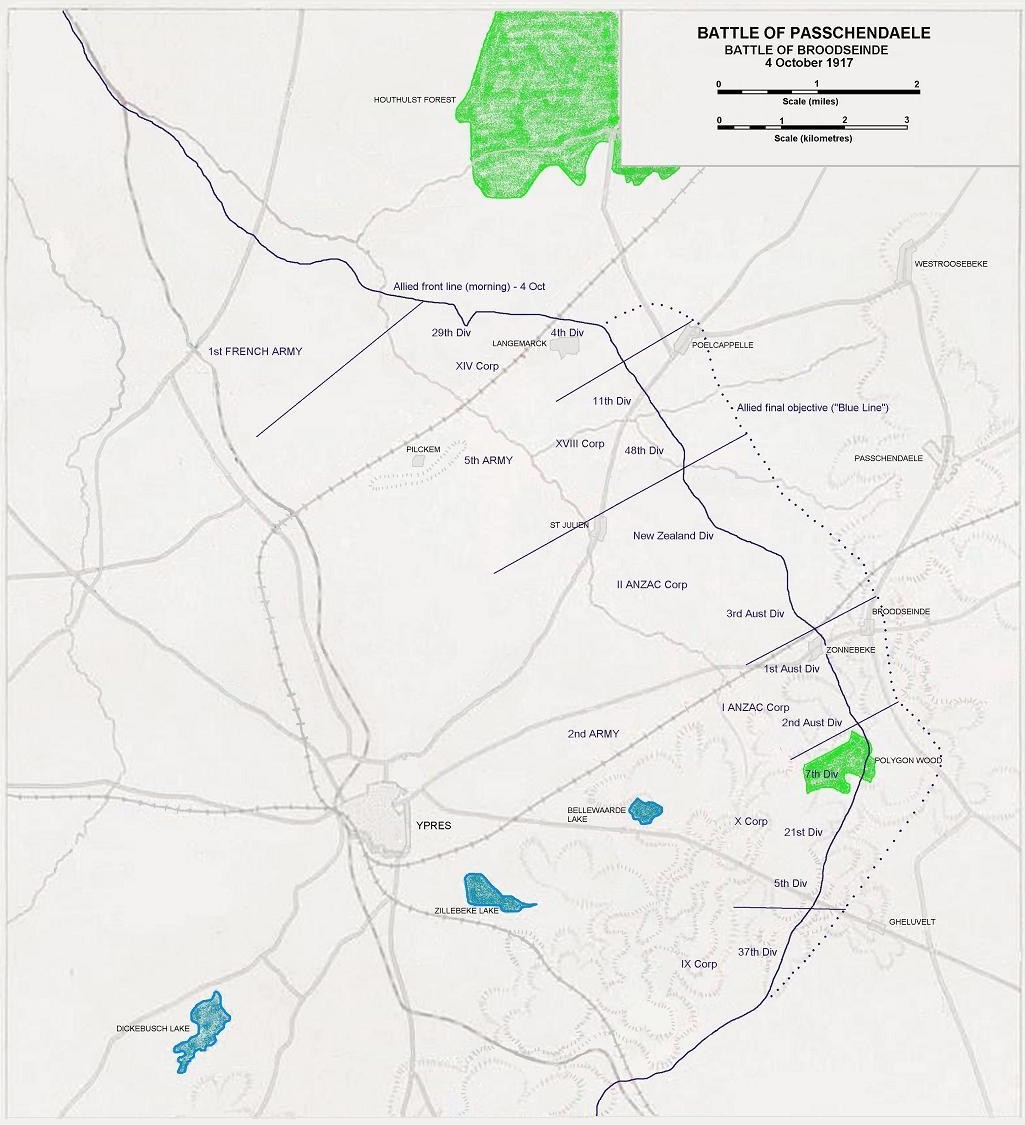
As the map shows, the Fifth Division was the second from the right, with its right flank resting roughly on the Ypres-Menin road. The aim of the divisions on the right was to cover the flank of the main advance, which was to be made on the centre and left. Though September had been dry, the rain began again on 3rd October, as the attacking troops moved into position. The Divisional History describes the ground, which:
... at the best wet and low-lying, and intersected by many streams and ditches, was now a morass. The intensity of the shell-fire had destroyed everything, and the whole country was a vast wilderness of mud, water-logged shell holes, and lakes, with here and there the shattered stumps of trees marking where once had been woods. No vestige of a building remained anywhere. The roads had been destroyed, and in place of them plank roads had been made across country ... once off these roads vehicles sank up to the axles in mud ... For the movement of dismounted troops "duck-board" tracks had been laid for miles across country. These tracks were narrow, and movement among them in the dark was difficult, especially as, when two bodies of troops met, one had to leave the track and flounder in the mud at the side. Enormous water-filled craters were everywhere, and into these many men fell. At best this meant a ducking in filthy water, but in some case, men, weighed down by their equipment, were drowned.
As the Devons moved into position, along the slippery narrow tracks, their Commanding Officer, Lt Col Duncan Hamilton Blunt, DSO, and his Adjutant, Lt Sir Burton Robert Williams, were both killed by shell-fire. The Regimental History observed that "Col Blunt had done great things with the battalion, which put great trust in him; the officers were wont to say he could walk through any barrage". But they pressed on, reaching the starting positions in good time despite the conditions - "zero-hour" was 6am.
The 1st Devons attacked on either side of a stream called the Reutelbeek, running east-west, normally small, but now "an impenetrable morass 100-200 yards wide", as described by one man. Three companies were to the south of it, on the right, and one on the other side, to the north. Keeping up with the barrage was very difficult because of the conditions, and it was impossible both to keep to the right direction, whilst also avoiding the swamps. However, according to the Regimental History, although the mud delayed movement "it was so soft and deep that it smothered the shell bursts".
The attack encountered very strong resistance, because German forces had been assembling for their own attack. On the north side of the Reutelbeek, No 4 Company, with the Duke of Cornwall's Light Infantry beside them, made for a small wooded area called Cameron Covert. A bog at the southern end, near the stream, proved impossible to get through, so they were forced to consolidate a position at the other end of the Covert. They were then subjected to enemy counter-attack, but reinforced by two companies of East Surreys, were able to hold their position, though only one officer and twenty men were left.
On the south side of the Reutelbeek, No 3 Company, with No 1 in support and No 2 in reserve, also found German forces in strength. Their objective was a position between the stream and Polderhoek Chateau, which was a strongpoint on a crest surrounded by "pill-boxes" held in considerable force. The woods to the north-west of the position had been cut down, and machine guns swept the surrounding area. Polderhoek Chateau thus proved an extremely difficult position to overcome.
Those that were able to reach the final objective were soon lost; but the majority were able to reach a position north-north-west of Polderhoek Chateau, and hold it until they were relieved on 6th October, notwithstanding considerable enemy artillery fire and under counter-attack.

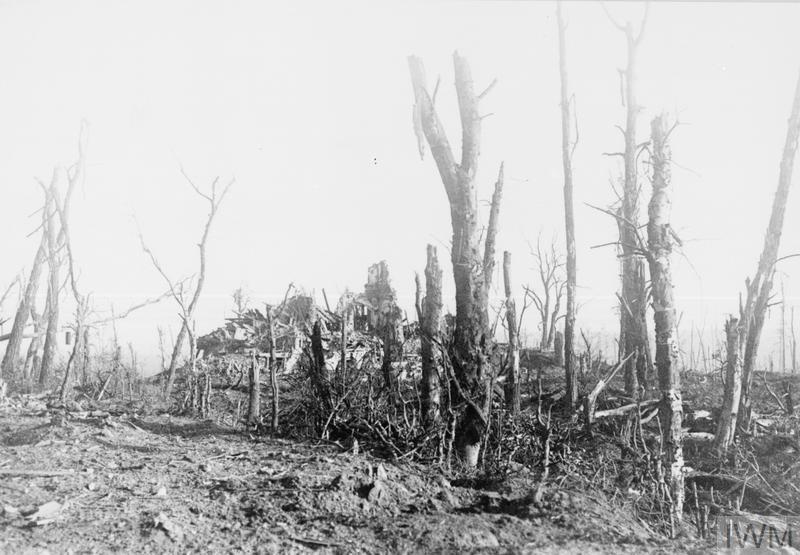
The Battalion's War Diary observes that "severe casualties were inflicted on the enemy during [these] operations", and approximately 50 prisoners taken; but the 1st Devons had suffered heavily too. The War Diary recorded that, in addition to the Colonel and Adjutant the evening before, four officers and 52 other ranks had been killed; three officers and 50 other ranks were missing; five officers and 189 other ranks had been wounded; and one officer was wounded and missing.
Although the 1st Devons had encountered severe difficulties at Polderhoek, the attack of 4th October 1917 overall was successful, the two Anzac Corps meeting all their objectives. The "bite and hold" tactics continued.
Death
It seems that, immediately after the attack, Eddie was one of those reported missing, for he was so described in a letter written by a family member dated 20th October 1917 (see sources below). But confirmation of his death must have arrived soon afterwards, for the Dartmouth Chronicle of 2nd November 1917 included an announcement from Eddie's parents:
Deaths
Burnell - October 4th, killed in action in France, Lce Cpl Edwin Burnell, Devon Regt, beloved youngest son of Mr and Mrs Burnell, Post office, Dartmouth, age 25 years.
"Peace, perfect peace"
The Dartmouth Chronicle also included a short piece drawing attention to the family's "treble bereavement":
Three Sons Killed in Action
Mr and Mrs Burnell, at the Dartmouth Post Office, will have the sympathy of everyone in the further cruel loss they have sustained by the death of their youngest son, Lce Cpl Edwin Burnell, of the Devons. This unfortunately, is the third son Mr and Mrs Burnell have lost in this terrible war - all killed in action on the Western Front - and they were, all three, volunteers.
Lce Cpl Edwin Burnell, the news of whose death has now been received, had been in France for two years, and for some time served in the bombing section of one of the Devon battalions, raiding the German trenches and capturing with his comrades many prisoners. Subsquently he was transferred to another battalion of the Devons, and at the time of his death he was serving as a machine gunner. His widow and two young ones are residing in Victoria Road. Mr and Mrs Burnell have also four sons-in-law on active service.
The following week, 9th November 1917, the paper included an announcement from Eddie's wife, and acknowledgement from his parents of condolences received:
Deaths
Burnell - Oct 4th, killed in action in France, Edwin John Burnell, dearly beloved husband of Jane, and darling daddy of Billy and Terence, aged 25 years.
Thanks
Mrs E Burnell, widow, and Mr and Mrs Burnell and family desire to thank their many friends for their sincere sympathy in their sad bereavement.
The loss of Edwin Burnell was one of several occurring at this time amongst men from, or connected to, Dartmouth, commented upon by the Western Morning News and the Western Times of 5th and 6th November 1917, respectively. The week in which news of these deaths was received was described as "Dartmouth's Terrible Week":
- Edwin Burnell, one of three brothers killed in action
- Leonard Hearn, one of two brothers killed in action
- John Webber, one of two brothers killed in action
- Frederick Widdicombe
Two other Dartmouth men were also killed on the same date as Edwin Burnell: Thomas Rendle and Frederick Worden, of whom the newspapers were not aware at the time. The death of William Langworthy, an officer in the 1st Devons, killed the same day and in the same action as Edwin Burnell, had been reported in Dartmouth a couple of weeks earlier.
Commemoration
As one of the 35,000 men of British and New Zealand forces who have no known grave, who died between August 1917 and November 1918, Eddie is commemorated on the Tyne Cot Memorial, near Ypres (Ieper). Tyne Cot was originally a barn, around which were several fortified "pillboxes"; it was captured by the 3rd Australian Division on 4th October 1917, during the Battle of Broodseinde.
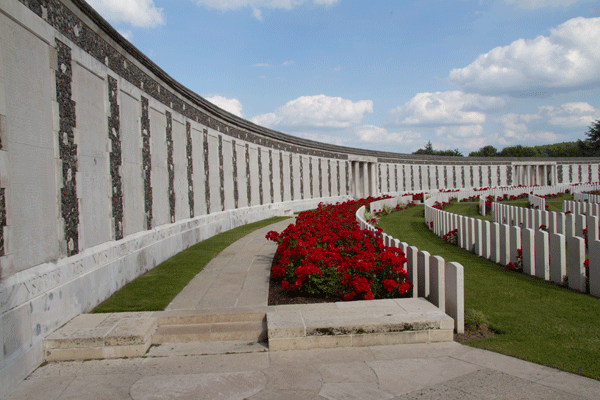
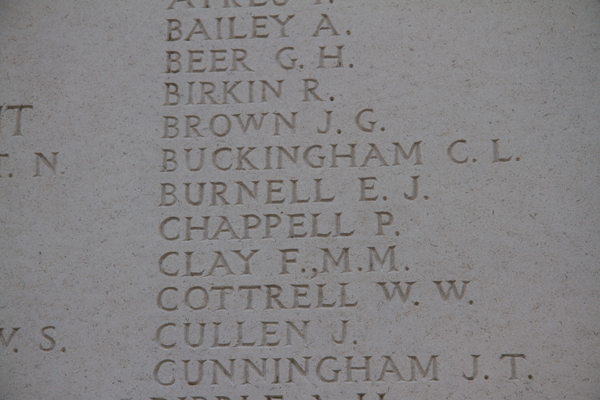

In Dartmouth, he is commemorated with his brothers George and William on the Town War Memorial, the St Saviour's War Memorial Board, and on a single panel of the St Petrox Memorial devoted to the Burnell family.

















